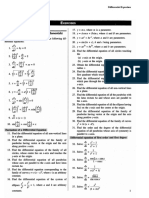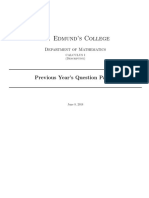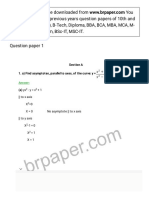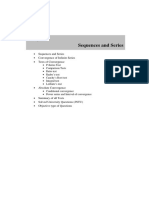0 ratings0% found this document useful (0 votes) 842 views23 pagesTracing of Curves
Curve Tracing and Study of solids
Copyright
© © All Rights Reserved
We take content rights seriously. If you suspect this is your content,
claim it here.
Available Formats
Download as PDF or read online on Scribd
Tracing of Curves and
Study of Some Solids _)
1, Introduction
For evaluating areas, volumes of rovolution ete. we nest to know the general nature of hy
‘iven curve. In thi chapter wo chal eam the mathods of tracing a cura in genaral and the peopeien *
Of soma standard curves commonly met in angingoring problems
2. Procedure for Tracing Curves given in Cartesian Equations g
1, Symmetry : Find out whether the curve Is symmetrical about any line with the Ret ofthe
following rules
(The curves symmetrical about the axis the equation ofthe curve remains unchanged
when ys replaced by~y £2, ifthe equation contains only even powers of y.
(i). The curve Is symmetrica about the y-axis ithe equation ofthe curve remains unchanged ”
when xis replaced by — x Le. ifthe equation contains only even powers of x x
(li) The curve is symmetrica in opposite quadrants if the equation of the curve remains
unchanged when both x and y-ara replaced by ~ x and y. s
(iv) The curve‘ symmetrical about the ina y= xi he equation ofthe curve remains unchanges
‘when xand y are interchanged. ™
2. Origin: Find out whether the origin lies on the curve. If dows, find the equations of he
tangents atthe origin by equating to zero the lowest degree terms.
3. Tangent at the origin : Tangents atthe origin are obtained by equating to zero, the lowest
degree terms
4, Intersection with the coordinate axes : Find out the points of intersection of the cue
‘withthe coordinate axes, Find also the equations of the tangents at these points
5. Asymptotes : Find out the asympiotes i! any.
6. Regions where no part of the curve les : Find out the regions ofthe plane where no past
curve lies.
7. Find out dy! dx : Find out dy / cx and the points where the tangents are parallel othe
axl,
‘Straight Line
“Goneral equation of straight line is of the form ax + by + c= 0.
To plot a straight ine we put y= 0 and find x. Also, we put
d join them to get the required line,
particular cases of straight line are shown below,
and find y, We plot these two�=e neering Mathematics It
id : et (1a)
Lines paral te the coordinate asa,
Fig. 1.1 (8)
(Lines passing through origin
ins une Fig. 14.2 (a)
: Fig. 112)
% {u)_Unes making oven intoreopts on coordinate axes,
Fig. 11.3 (a) Fig. 11.3 (0)
4. Circle
General equation of circle is x? + y? + 29x + 2fy + ¢= 0. Its centre is (- g,—F) and radius
=\es Pe,
ere nop (Circle with centre at origin and radius a. 2+ P= a? CFig. 11.4 (@)]
allel to (il) Circle with centre at (- g, — f) and radius 2g? + fc, [ Fig. 1.4 (0))
y dertme
nose t i
Fig. 11.442) Fig. 11.4 (0) is ,�(ai Cirete with conte on tho a-axis and passing through origin
Its equation is of the form a? + yx 2ax= O.orr= 424.08 0
xityte2ax=0
r=" 2aco80
Fig. 11.5 (@) Fig. 11.5 (0)
(iv) Circle with centre on the y-axis and passing through origin.
Its equation is ofthe form x? + y? 2by= 0 or r= + 2b sin 0,
12—2bsin0
Fig, 11.6 (a) Fig. 11.6 (6)
(9) Gircle with centre on the axes but not passing through ortgin
Ds equation is of ho form x+y? 2gr+-0=0,x"4 y? 2219+ 00.
[See Fig. 11.7 (a) and 11.7 (6)]
“Circle touching both axes, its equation is of the form x? + y?+2ax# 2ay+a?=0,
Fig. 11.7 (0) Fig. 11.8
jon of parabola is
yaar’ +ox+c or x=ay + byte
the square on x or on y and by shiting the origin the equation can be wrtien in
f= dax or x? = dby.
ig mothematies=
ene
Fig--
equation of oF
re Se paral 1
. axis paraliel toh
paral 9
ris paral
Ellipse
Equation of ellipse
20,0)
F
lt the centre of th
As belore if a>
Oto ree ae�Fig. 11.9 (a).
“The equation of the parabot Fla tg
i fa with vertex at 9 (by
Pps pratt 9, opening one am
allel to the x-axis, en
ae tet
cir wren omen cnpcget
Ys, pening dovinwardnis (oo) Y=)
NOS I6 (xh?
=~ daly—k)
hts (yogi
Fig. 11.11 (a) Fig. 1.11 (0)
sof the ellipse is at (h, ) the equation of the ellipse becomes
(xm? U- KEL,
«As before ita > b, the major axis Is parallel to the x-axis andita< bine
major axis is parallel�a -
eerie Ma
mathematics (rs) ee ens
Engineering ,
7. Hyperbola
Equation of hyporbola in standard form is. 2 —
y
at
b note the
Fig. 11.12 (0) Fig, 11.12 (0)
bol: 10. Graph
8. Rectangular Hyperbola oad
ifthe coordinate axes are the asymptotes the equation of the rectangular hyperbola is xy= erste a
oye k oh!
y
= a Z
ny=k nye-k a
Fig. 11.13 (a) Fig. 11.13 (0) Siral
line y=-+ x and y=— xa the asymptotes the equations of the rectangular hyperbola are y
6
xy
Fig. 11.14 (a)
Fig. 11.14 (b)
mic and Exponential Graphs
[Below some logarithmic and exponential graphs for different bases,�=o
Fig. 1.15.6)
Fig. 11.15 fa)
and y= a are symmetrical with respect tothe tina ya,
oto tat the ahs of Y= 100
so. Graphs of the Form yh ax?
sider the gtaphs of the form
‘we first oon
teat wah come of tem ane You have come acr
yP= x4. (Fig. 11.16 (1) t0.(1
On A omen crmnera
ae
wut eaten
Eee
ee yok
bE
ovat ’
Apair of vertical parabolas: (in) v=
Fig. 1. 16 contd.�ay
A pair of horzontal parabolas
yt
h
(96) y=108 (17) y= thkiery=t
‘rectangular hyperbola
Fig. 11.16
11. Graphs of the Form y = (x - a) (x - b) (x - c)
Geary the graph intersects the xaxis at x= a, x= b, x=. Also as x+=, yo, and ag
x+—=. y-+—o We consider one particular case here.
Example 1 : Plot the graph y=
Sol. : We can factorise the rh.s. and get
(2?-x-2)
(2) (x= 1)
Hence, (0,0), (1,0), (2,0) are the points on the graph.
Wo 38 -2x-
Since 7 = 9x -2x-2
Fig. 11.17�sng Mathematics
neering M " (ray
|42-Strophoid
Kmamplo:Te0c0 he CUNO Y* (844) KE yy,
a" navical about tho ail
; through tho ogi andl the oni
HO Fre cerane tango athe erin ara :
y= + (bia +%
[Fracurve mvets tho ax 0 (0, 0 ned (8a, 0)
ie 2-2
oa. Y= Innny Hence, == nan
tron
x> pandwhes x <—a, y?is negative, Hence, Fig. 11.18
9 does not exists when x> band x<~ a, The curva is shown inthe Fig. 91.18
got above (yp Is called a loop. Wo show below cota common loops
(Fla. 11.19)
(Fig. 1.201
(Fig. 1241
Fig. 11.22)
5) (x ~ 50)? [ ig, 11.23 00 the net page |
or Say? = x(x- a)? (Fig. 11.24 on the next page |
(Fig, 11.25 0n the nox! page }
Fig, 11.20
y
ian) *
Fig. 11:22�Tracing of ¢
a9)
iz >i. &
% of aN
Fig. 11.24
engineering Mathematic
© 14, astroid or Fo
example : Trace th
‘cure is sy
sot. : 0) The
(iy The curve cuts
(i) Neithar 0° ¥
(Geo Fig. 11
Fig. 11.28
ssoid of Diocles voit
(ea-x)=*
45. Witch of Ag
Example 1 : Trae
sol. : (The curveis 8
(i) The curve pas
ns ra about the x-axis.
a eee and th tangents atthe origin
at the origin.
Example 1: Tra :
‘ihe curves is symmettc
r. igh tho origin and
js ig @ double tangent
curve passes throu
29 /¢, he xa
5 =, the line x = 2a Is an nae
ae x9 28
ter than a.
(Wy Asx 0,y-
Example 2 : Tr
+ The curve is si
ts negative. Henee, the curve does nat exist
Tain 6, wo can show that the polar equation of Glesoig
asin’
Bor x= asin’ t, y= 22" in parametric form.
Trace the curve ¥ (ax) =*.
to the above curve with 2a replaced by a.
gh the origin and the x-axis is a tangent at the origin,
xs at (0, 0) and (0, 2a). Further, dy/ dis zero at
at this points is parallel to the x-axis,
=y)/a? when y> 2aand y <0, xis negative
ot exist for y> 2a and y <0,
peu a? =s3(0a-y
about the x-axis,
‘Origin and the point (2
‘a, 0). Since
Hangent at his points paraliel to the�IEncineerine Mathematics -1
: (1120) cat
P+ Astrold oF Four Cusped typo
J Example Trace the curve 4 pts
" i ty gn a
* tT caves symmetcn cpa = 2
v0 fs symmetrical ae
(i) The curve cts the waxistn a he
(i) Neanar anor ycan be g
(See Fig. 11.29)
(24.0) andthe
‘nae ne Pm 2.
15. Witch of Agnesi
Keample : Tis the binis: ay? a? ag
(0) The cue is symmetrical about the ax, i
(8) The curve passes through the point ao,
(iy Since y? = a? =)
x
eater than a,
Bol.:
+ Gannot be negative, Also, x cannot be |
(¥) ASX 0.9, the yasis is an asymptote.
Example 2: Teoe the cure ?= 4a? 2a x) co
ol. The cure is sma othe curve shown above whet is place by 2a
Example a: Trace the uve a? y2=2(9?_ x2,
ol. :() The curve ie symmetrical about both he axes
(0) The points (0,0). (, 0) and (= 2, 0) e.on the curve
i) It x> a, ¥? is negative, Hence, there Is no curve beyond x= a, x
(2a) (S00 Fig. 11.31 below) ]
y
a0), a0), Ly
—a es
y re
1.27
Fig. 11.31 Fig. 11.32 i) 4
Example 4: Trace thecuve x (a*-¥)=82 7. s
. : Because the powers of both xand y are even, the curve is symmetrical about both the axes.
> aorx<~a, there is no curve.
ya, 0) Xx Equating to zero the lowest degree terms. The tangonts atthe origin are y= #2V2-x. 3
e (See Fig, 1.32 above) 3�<<
RO
te
aay Tracingot
Engineering Mathematics!
ple §: Trace the curve ya (6=2)
£0 eee Lymmetica about ote axes, (800 FG 11.80)
‘ho point (0,0), (2.0), (2, 0} He.on the curve
thas 2, 7s nagatve, Hence, there i no curve beyond
‘example 2 : Trace the eure
sot: The curveis sitar tothe at
(eg. 11.96)
“The curves syrmetic abot
sine chante |
tine cure romaine unchanged
Fig. 11.83 Fig. 11.34
Example 6: Trace tho curve a x = ay (a? — 7),
When 1.x= 0. Then origin lies on the curve. {See Fig. 11.94 ]
Wy> a. xis imaginary. Hence, the curve ies between a< y< a
Equating to zero, the lowest degree terms, the equation of the tangents at the origina
i=),
by
47. Lemniscate of Be!
olium of Decartes
ple1: Trace thecive x34 y%=Saxy.
‘curve is symmettical about the tne x= y because
= Since the curve has ever
dy y-and iy is replaced by x, the equations Sols ee
ro ee
Be pes sich ocd oe
Be iicecs ino no x= (0, 0} nd (goer. 8
is an asymptote.
LY<0,|8.s.is negative while ch. is positive, Hence, no part ofthe curve sia
epher, soldier and mathematician was bom in the town of La Haye
At he age of 8 he entered the Jesuit College of Henvi IV in La ve he sera a
grammar, science and mathematics. Because of poor heath he developed Cocoa
unt late in the morning; he considered those times most productv
4nd travel through Europe for 5 years he retumed to Paris and�0 Fig. 11.34]
fangents at the origin
Fig. 11.35
No part of the curve is
s town of La Haye (no
3 Hen IV in La Fle
oor health he develo
"times most productive.
returned to Paris and
ceineeine Mathemates tay
‘uted Mahan
werd fr went yoo
NY’. But my eee
OF importante ne
Ergo Su" (tink, trenton s SPO
tn (1) Discourse on ine tl
Conducting the lesson anes © Methog of Righty
‘Meditations on Flest Philosophy and {ay Ponsa Science. (3)
{utor het in Phiosophy Here he contacted banaue, iat
: aoe
Example 2: Trace thecune x3—y? = say
‘Sol: The curve i similar tothe above ane but esin the third qian,
Fig 11.38)
‘Thecurve is symmotic about the ne y= xbecause the equation
‘ofthe curve remains unchanged iris replaced by - yan ys replaced
by-*
17. Lemniscate of Bernoulli
example: Trave thesia Re Saaea rea
of Mao
x e-x)
« ee
01: irc ho cuve has aven powers th ad. le
Syrietial about he xd
"ha cune pesees tough (0), (0) and (+0
Th ines y= and yf anges he or
(S00 Fg. 1.37)
Example2:Tracethecuve XP =a(y-#)
Solution ; Sines x and y both appsar in even powers the . 3
‘cure is symmetrical about both the axes,
it passes through the exign andthe tangents at the ~
origin ae y
‘The equation can be wen 38
Peele) 2 ete
are the asympotes atthe origin
(See Fig, 11,98)
Fig. 11.98�pe [abe~ gis
(as)
engineering Mathematics 1
i
18, Procedure for Tracing curves given I
polar Equations
| 4c Find ut tho mony ae
: ,ymmetrical about the ‘initial ine,
sth PO
tay 112m replacing rbY
pee curve ayant 8°
1 the totlowing 108
Fos th tt 1 rtortotm postive and Ne
3. Find ono => oto ports wherotaz0r0 oF Mn find the points at when ae
nit i vpn ie
tnt oe tatoo can ia at me teal OA
nuttin lve ore in wou cat oe : re potar oust
poa2acosd
“re par ova
i pas BDsin®.
19, Polar Equations of Lines
cata apt etn fh asta SH Eat ESET
21. cardi
fequition of tho paxis is 0 = 1/2,
example
‘gol. : (2) () The oun
replacing @ By ~
(@ When 0=¢
‘Also when
(i Further t
Fig. 11.99
ithe line y= xis rsin0=rcos 0 ie. tanO=1,e.0=2/4
er ~xis rsin 0 =~roos 0 fe, tanO=~1 .e,0=9n/4.
eet ta AlooeCtermucc ml
¥=bi0.o1 rsind = bis r= b/ sin Oi.e. 0�Engineering Mathematies - 1) ;
atta)
20. Polar Equations of Circle:
The polar equation of
ion of the circle x 4 a a?
+P Pla? conto 4?
000 0 +7? ein?
y
r= 2b8in0:
Fig. 11.40 (a) Aidt saa Pay —pby=0
ae Fig. 11.40 (b) Fig. 11.40 (¢)
6 polar equation of the circle
podsaeces: f the circle x2 + 2 + 2ax=0is r? cos* 0+ r? sin? 0 = 2 2a cos Bie.
‘The polar equation
eee quation of the ciclo x2 + y+ aby =0ie Poos* 0+ # sintia == 2brsin Oi
21. Cardioid
Example 1 : Trace the curves (a) r= a(1 + 080), (o)r=a(1 cos)
ine since its equation remains unchanged by
Sol. : (a) () The curve is symmetrical about the intial
replacing 0 by ~ 2.
(i When 0 =0, r= 2a and when 9 =
‘Also when @ = %/2,r=aand when ®
de _a(i+oos6)
Furor en oe = Can
0) un(Ea2 = '
. mo =-ca(2)=in($+5) Ce
ais eos0)
> 2 ho the tangant ati point paren to the inital fine, When
ne tangent at this point eoinees Wh initial tine,
ome values of rand 0
a2 | 208
alz
‘When 0=
oan Y= 2nie.
(jv) The following table aves &
e 0 3
r a | 3a/2| 2�11-18)
6
tngingering Mathernatet _—
tho equation i? + 777
1 consi
venison de! Awe ane at
‘example 2: Trace the cure
ge saath)
Fig. 1142
spot coeds with to tele whan
ele ote a He
J‘ = 0 ke the tangs
tna a ect rang®
2a
aa (1~sin0) are shown below.
vo more carionae r= actin) and
‘example 1 : Trace the cure
‘Sol: we put x= e058. y=
rorsinO= 8
eea(1-sino)
Fig. 11.43 (b)
raa(t+ane)
Fig. 11.48 (@)
Bernoulli's Lemniscate
Pad cos28
ey? =. ay)
oo ‘Example 2 : Trace the
tengng by ~ rhe equation remains cosy
fable petal aout inline, sate ee
reeand=a
Seton bara ~0 te eqaen mans
“Site Fie, kg s(a-rsin
es a®-2al
only postive value cr, we get the following table.�Teseing of cures
Bat ae from x? ~y? Oba yw x he
Example 2; Trace the curve si 28. sos
sasaaiecon nau to
Teoneh iamene saiieara
sone
nd = n/2
23. Rectangular Hyperbola
Example :Tave the curve Fig. 11.45
o 250 20
or xtayteat
Sol: we putxs 16080,
12 (cos 0st
Je, Peoe2et or r= a? sec 28
Fig. 11.46 ‘The points (a, 0), ©, 0) re on the cure 0 = n/4 and
= n/ 4 are the abymtats.
24, Parabola
Example 1: Trace the cue r{1~and}=a
Sol: we pu x= re080, y= sn, we have
r= reino=a
Peles rsino®
Paabecarinde hata
wPeytea?eaayey?
x2=a(ar2y
which isa parabola as shown in Fig, 11.47 (when y= 0, x= 2
(nen @ = 9x72, r= a2)
Example? :Trace the cuve f(t +8in@)= 2:
Sol, : we put x= 70080, ¥=
rersind=a
7s (a-rsin OF
sin 0+ Fin? 0
xeeyPaa?—2aysy®
x? a(a-29)
hich sa parabola as shown in Fig. 11.48 (when y= 0, x= 8
(When 0 = /2, r= a2)�Engineering Mathematics -!i (iz)
25, Cycloids
Acyeloidie @ curve traced by a thxod point on the
circumference ofa circle which moves uniformly on @
straight ine without siding
ifthe maving circle moves on anther etele rom
cutside oF from inside we got an epicyciold or an
hypooyeld
Example 1 : The eyelold is generally given in one of the following forms.
lw@xea(tcent, yeattscost) — (by #ea(t-sint), yoa(t +c08t)
(xna(tesint), yea(i-cost) — (@) x=att=sint), y= a1 —cost)
‘a oy ay syle asin’. tag( t
Sot: a) B= a(toosn, Gm =asint tPF aise
Some of the values of x, yand dy/ dx are
t [-«| -s2 | 0 =
x |-ax +} 0 an
y | o a 2a a 0
dyldx| 4 o | -1 [-#
Fromithe above table we see that at t=—x and at
y
=asint
“ai cos)
Fig. 11.49
the tangents are parallel to the y-axis.
ts are called cusps. Further, at ¢= 0, the tangent is parallel to the x-axis,
x=a(t+sint)
Engineering Mathematics
C�‘Tracing of Curves
(1 +008)
(1=c0s 1)
allel to the axis,
engineering Mathematics -i) en tee
y
Fig. 11.51
2 stan ee . at
© Sati scost, & « asint = van( 5)
some of the values of xy, 2 are
8 ues of xy.
Fig. 1.52
, Hala ws
ax \ex/at ~ att— cost)
=a(1~c08), % = asint
Some of the values of x, dy/ dx are
x2 3x2 | 2e
2)�Engineering Mathematis =i! (a9)
uu 26. Tractrix
1
Example : Trace the cuye = x= eos t+ 3 alogtan’
sate 2s 2ianit/2) 98022) (1/2)
eee vant(¢/2)
asin rot ere =~ asin +
Zain(t72) cos 172) ant
Y. acost
ar
Some of the values of 3. ¥. dy dare
t= [-a2[« [eal «=
x[=f{eof--[o]| =
P| 0 fae pao [ead se
wie] o | -# | 0 | = | 0
From the above data wo s00 that as ¢—— x the point on the curve is (~, 0) and.as 1-4
Points ~, 0.
Biplane anc! aight in tee dimensions We
Bimensional solids such fe
engineering Mathematics 1
simeloat planes ar the ye pana wh
ya 0: the Hy plane whose equation 2)
“Tre planes paral othe comet
Fig. 1.58
“The plane ax+ by + e2= 1 culag
common form ofthe plana is
“This plane outs of intercept
29. Prisms
It tree planes intersect in =u
any two of them saline parale ts
called prism. (See Fig. 1158)
30. Tetrahedron
‘The soli formed by four
‘2 point is called a tetrahedron
Y (z, x) = 0 represent oyinds
(Gee Fig. 1.60)
(a) Right Circular Cyl
cevlinder, whose generator�imptest planes are the
Iy- 0; the xy plane whose equa ne
plane wove aaustion,
‘Tha planes paral te mo e
hone
(=, 0) and.as ts gy ‘This plane cus of ierepts 4b con the cocina
29. Prisms
tee planes intecsct in such way tat
way tet te nrscton
any of tem saline paral to the thed hn te sl ems
called prism. (See Fig. 11.58) -
30. Tetrahedron
‘The solid formed by four planes any three of which imtersectin
«2 polnt is calied a tetrahedron. The figure shows a tevahedron
formed by the coordinate planes and the plana
«S00 Fig. 11.69)
31. Cylinders
'An equation involving only two variables represents a cylinder
Jn three dimensional geometry. Thus. f(x. ¥) = 0, f(y. 2) = 0,
¥ (z, x) =0 represent cylinders in three dimensions.
(Soe Fig. 11.60)
ons. We shall hare.
(a) Right Circular Cylinders : x®+ y= ais aight kevlar
cylinder, whose generator Is parallel to the Zaxis. Similarly,
y°+22= 07 is acylinder whose generators are parallel to the x-axis.
to the
‘c? is @ eylinder whose genoralors are parallel
ten
s (= 0; te 2
Facing ot Carve
Fig, 11.60�(ren)
1 neineering mathemati!
Seen imenca- th el
32. Sphere
Fr sees tm |
poe
23. Cone
“The og cat eben ian by?
D totoning Fag 1 88h
rig. 1481
“ho aherwocenas Fast
a st the section a he oyinder By 3 re ER aac
2) ote Cvinere ors an oie then te inde emery
tare powers
cylinder whose oe
Ries ellistc exlindr 4 Is: eylind
Simla, we have elite
wel ae tthe ena '
ane Cs V
¢) “oo *
34, Ellipsoid
“The equation of liso in tan
2
eee
“Tho sections of the stiossd
Fig. 11.65 coordinate planes are clipes. See
xx represents a parabola in two dimensio
35. Hyperboloid
“The hyperbolld of ene &
in Fig, 11.70 (a). Sections oft
parallel to the
olipses
‘plane are hypsttoas
The hyperboloid of two {
in the Fig. 1.700)�53
ensions.
tlowing
Engineering Mathematics - i (1122) Tracing of Curves.
32. Sphere z
is shown inthe — ™,
‘The right circular cone gh x
ar cone given by x + y
followin
9 Fa. 11.68 () ca
‘The other two cones y# + z?=.x®and x*+2=y?are shown in
the following Fig. 11.68 (i) and (i).
Te!
iy
Fig. 11.68 : Cone
34, Ellipsoid
“The equation of elipsoid in standard form is
ees
eee
The sections of the ellipsoid by planes parallel to the reat
coordinate planes are elipses. (See Fig 1.69)
35. Hyperboloid
“The equations of hyperbotoid of one sheet and two sheet are respectively
z
and WH
‘The hypetboloid of one sheet is shown
in Fig. 11.70 (a). Sections of the hyperboloid y ry
‘of one sheet parallel to the x-planes are 4
flipses and sections parallel to yz-plane or % x £1 IN
‘zxplane are hyperbolas.
“The hyperboloid of two sheets is shown ee ig. 11.700)
in the Fig. 11.70 (b)�



































































